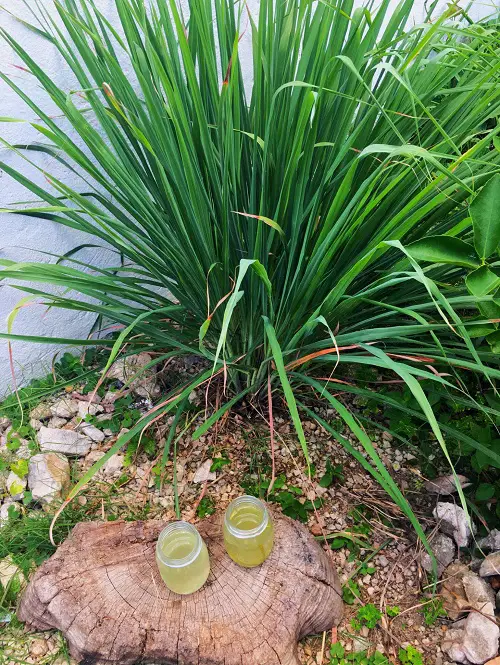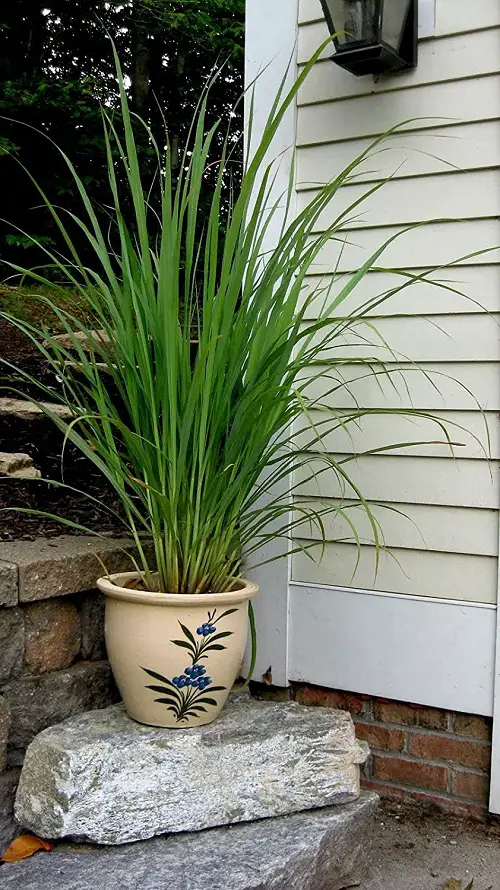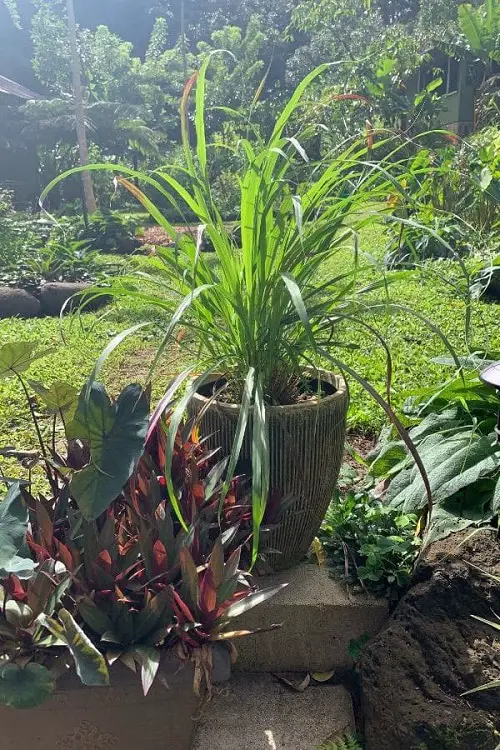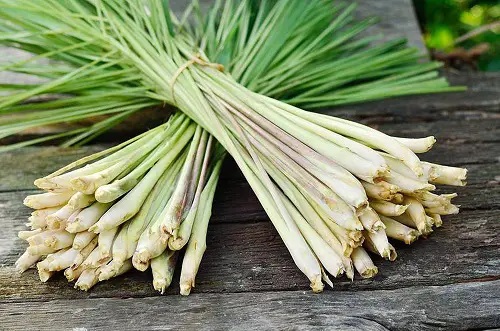Follow our guide on How to Grow Lemongrass in a Pot and Lemongrass Plant Care to grow this plant easily in your home garden!
Learn How to Grow Lemongrass in a Pot and everything about Lemongrass Plant Care that will help you grow it easily!
USDA Zones: 8-11
Botanical Name: Cymbopogon
Learn how to grow Lemongrass from seeds
Lemongrass Information
Lemongrass is a tropical perennial herb in USDA Zones 8-11 and can be grown as an annual or in containers in colder regions. This tropical herb can grow quickly and spread to fill a container or garden bed.
You can quickly expect a plant to grow up to 3-5 feet tall and 1-2 feet wide in just one growing season.
Choosing the Right Container to Grow Lemongrass
The perfect size for the container to grow Lemongrass is a 5-gallon container with 14-18 inches diameter. The roots are prolific and need plenty of space to grow up, and if you plant them in a smaller pot, the roots can break the container.
You can start with this size and eventually transfer the plant to a larger pot when it grows and spreads. Also, make sure the container has plenty of drainage holes.
Best Varieties of Lemongrass
Lemongrass comes in two main varieties: East Indian and West Indian.
The East Indian variety is famous for its thinner stocks and darker red stems. The West Indian type is more commonly used in cooking because of its flavor and greener stocks.
However, both varieties have very few and slight differences and can be grown under similar growing conditions.
Have a look at the best grass-like plants
When to Grow Lemongrass?
Lemongrass prefers hot and humid climates and grows as a perennial in USDA Zones 10-11 and as an annual in colder climates. If you plan to grow it outside, you may want to plant it after the danger of the frost passes away.
Remember that Lemongrass takes about 90-100 days and sometimes 4-8 months to get ready for harvest. You can grow the scented herb indoors any time of the year in a container.
Requirements for Growing Lemongrass in Containers
Location
Lemongrass is native to tropical zones and thrives best in sunny, warm, humid spots. Choose a spot that gets 6-7 hours of bright and direct sunlight for the best growth.
Avoid planting it in a shady spot, as it won’t promote bushier growth.
Soil
Lemongrass prefers well-draining, nutrient-rich soils. The soil should have a pH of 5.5 to 6.5 and should be kept consistently moist.
An ideal lemongrass soil is a sandy loam with plenty of organic matter, such as compost, added to it. Good drainage is essential to prevent root rot, so it is important to make sure the soil is loose and not overly compacted.
Adding a 2- to 3-inch layer of mulch can help retain soil moisture and suppress weeds.
Watering
Lemongrass is a tropical plant that prefers moist but well-drained soil. It should be watered regularly throughout the growing season, allowing the soil to dry out slightly between waterings.
In the winter, water less often, but do not allow the soil to become completely dry. The tropical herb does not tolerate dried roots, which can be one of the easiest ways to kill the plant.
Temperature
Lemongrass prefers warm temperatures between 75-85°F (24-29°C). It can tolerate temperatures down to 45°F (7°C), but it is best to bring it indoors if temperatures drop below that. This plant can also tolerate higher temperatures, up to 100°F (38°C).
Lemon Grass Plant Care
Fertilizer
If you have used a good quality growing medium, then don’t worry much about feeding the plant. To boost the growth, use a balanced liquid fertlizer after diluting it to 1/2 of its strength once in 4-6 weeks.
Additionally, applying organic matter like compost to the soil will help create a more nutrient-rich environment for the lemongrass to thrive in.
Pruning
Pruning helps in boosting growth. Remove the dead leaves regularly; the first pruning season is usually 5-7 months after planting. The second session can be after a year from then.
Pests and Diseases
Pests:
Aphids: These small, pear-shaped insects suck the sap from the leaves of lemongrass, causing yellowing and distortion of foliage. To get rid of aphids, spray the plants with a strong stream of water or use insecticidal soap.
Mealybugs: Mealybugs are small, white, cottony insects that feed on the juices of lemongrass. To control mealybugs, spray the plants with a strong stream of water or use insecticidal soap.
Thrips: Thrips are small, slender insects that feed on the foliage of lemongrass. To control thrips, spray the plants with insecticidal soap or neem oil.
Diseases:
Downy Mildew: This fungal disease is caused by the fungus Peronospora hyoscyami and is most commonly seen on lemongrass. Symptoms of downy mildew include yellowing and wilting of leaves. To control downy mildew, treat the plants with a fungicide containing copper or sulfur.
Stem Rot: To prevent stem rot, keep your lemongrass in well-draining soil and avoid over-watering. If your lemongrass has stem rot, remove any affected parts and discard them. Treat the remaining plant with a fungicide, such as a copper-based fungicide.
Lemon Grass Winter Care
To keep your lemon grass alive over the winter, it’s best to bring it indoors. You’ll need to provide it with plenty of sunlight and humidity. Place the pot in a sunny window and keep the soil consistently moist but not soggy.
You can also mist the leaves regularly to help increase the humidity. Lemon grass is also sensitive to temperature changes, so make sure to keep it away from cold drafts or heaters.
If you’re looking for extra protection for your lemon grass, consider wrapping it in a blanket or burlap bag. This will help insulate it from temperature fluctuations and prevent the foliage from drying out.
Harvesting Lemon Grass
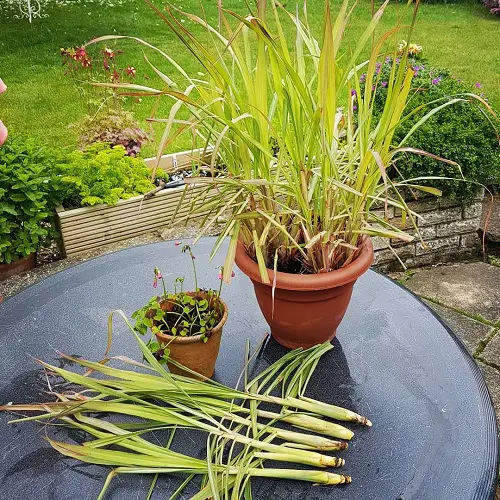
To harvest lemon grass, use clean scissors or a sharp knife to cut the grass about two inches from the root. Discard the root and use the grass for cooking, tea, or for making essential oils.
Preserving Lemongrass
- To dry it, cut the stalks into small pieces, spread them out in a single layer on a baking sheet, and place them in an oven set to its lowest temperature. Allow the lemongrass to dry for about four hours or until it is completely dry and brittle.
- To freeze it, cut the stalks into small pieces, place them in a single layer in an airtight container, and store them in the freezer for up to six months.
- To dehydrate it, cut the stalks into small pieces, spread them out in a single layer on a dehydrator tray, and dry at the highest temperature setting for about four hours or until the lemongrass is completely dry.



